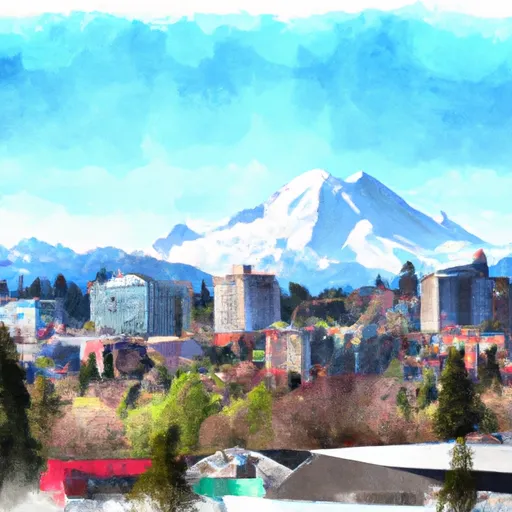-
 Snoflo Premium
Snoflo Premium
Get unlimited access to all our content
With no Ad interruptions! - Start Your Free Trial Login with existing account
Rainier
Eden Index
Climate
7.9
•
Recreation
3.1
•
Community
2.7
•
Safeguard
4.9/10

Rainier, Washington is a picturesque small town nestled in the Cascade Range of the Pacific Northwest. Known for its breathtaking views and proximity to Mount Rainier National Park, the climate in Rainier is characterized by mild, wet winters and warm, dry summers. The area receives abundant rainfall throughout the year, contributing to the lush greenery and numerous water bodies.
Hydrology constituents are a prominent feature of Rainier. The town is dotted with pristine lakes, rivers, and streams, offering opportunities for fishing, kayaking, and boating. The Nisqually River, originating from the glaciers of Mount Rainier, flows through the town, providing a vital water source for both recreational activities and the local ecosystem.
Outdoor enthusiasts will find endless recreation opportunities in Rainier. Mount Rainier National Park, located just a short drive away, offers hiking trails ranging from easy walks to challenging climbs, showcasing alpine meadows, glaciers, and waterfalls. Visitors can also enjoy camping, wildlife viewing, and snow sports during the winter months.
In summary, Rainier, Washington, offers a beautiful blend of a mild climate, abundant hydrology constituents, and a wide array of outdoor recreation opportunities, making it an ideal destination for nature lovers and adventure seekers alike.
What is the Eden Index?
The Snoflo Eden Index serves as a comprehensive rating system for regions, evaluating their desirability through a holistic assessment of climate health, outdoor recreation opportunities, and natural disaster risk, acknowledging the profound impact of these factors on livability and well-being.
Climate Health Indicator (CHI): 7.9
Rainier receives approximately
1244mm of rain per year,
with humidity levels near 88%
and air temperatures averaging around
11°C.
Rainier has a plant hardyness factor of
8, meaning
plants and agriculture in this region tend to thrive here all year round.
By considering the ideal temperature range, reliable water supplies, clean air, and stable seasonal rain or snowpacks, the Climate Health Indicator (CHI) underscores the significance of a healthy climate as the foundation for quality living.
A healthy climate is paramount for ensuring a high quality of life and livability in a region, fostering both physical well-being and environmental harmony. This can be characterized by ideal temperatures, reliable access to water supplies, clean air, and consistent seasonal rain or snowpacks.
Weather Forecast
Streamflow Conditions
Puget Sound
Area Rivers
Puget Sound
Snowpack Depths
Puget Sound
Reservoir Storage Capacity
Puget Sound
Groundwater Levels
Recreational Opportunity Index (ROI): 3.1
The Recreational Opportunity Index (ROI) recognizes the value of outdoor recreational options, such as parks, hiking trails, camping sites, and fishing spots, while acknowledging that climate plays a pivotal role in ensuring the comfort and consistency of these experiences.
Access to outdoor recreational opportunities, encompassing activities such as parks, hiking, camping, and fishing, is crucial for overall well-being, and the climate plays a pivotal role in enabling and enhancing these experiences, ensuring that individuals can engage in nature-based activities comfortably and consistently.
Camping Areas
| Campground | Campsites | Reservations | Toilets | Showers | Elevation |
|---|---|---|---|---|---|
| Tenino City Park | None | 287 ft | |||
| Joemma Beach State Park | 19 | 86 ft | |||
| Holiday Park Military - McChord AFB | None | 323 ft | |||
| Fort Lewis Military | None | 254 ft | |||
| Mayfield Lake - Tacoma Power | 55 | 444 ft | |||
| Penrose Point State Park | 82 | 15 ft | |||
| Ike Kinswa State Park | 103 | 445 ft | |||
| Camp Murray Beach Military | None | 239 ft |
Nearby Ski Areas
Catastrophe Safeguard Index (CSI):
The Catastrophe Safeguard Index (CSI) recognizes that natural disaster risk, encompassing floods, fires, hurricanes, and tornadoes, can drastically affect safety and the overall appeal of an area.
The level of natural disaster risk in a region significantly affects safety and the overall livability, with climate change amplifying these risks by potentially increasing the frequency and intensity of events like floods, fires, hurricanes, and tornadoes, thereby posing substantial challenges to community resilience and well-being.
Community Resilience Indicator (CRI): 2.7
The Community Resilience Indicator (CRI) recognizes that education, healthcare, and socioeconomics are crucial to the well-being of a region. The CRI acknowledges the profound impact of these elements on residents' overall quality of life. By evaluating educational resources, healthcare accessibility, and economic inclusivity, the index captures the essential aspects that contribute to a thriving community, fostering resident satisfaction, equity, and social cohesion.

